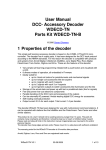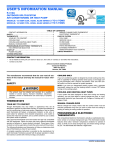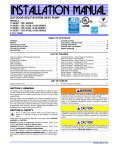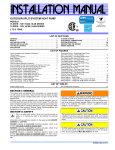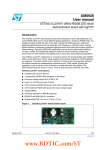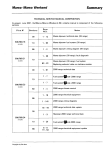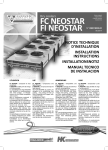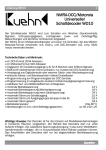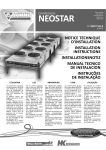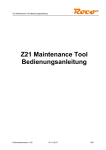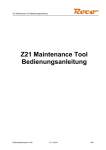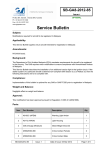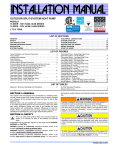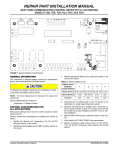Download User Manual for the WDecN-TN DCC Accessory - Bahn-in
Transcript
Manual for the NMRA compatible DCCaccessory decoder Assembled WDECN-TN Parts Kit WDECN-TN-B © 2006 Gerard Clemens 1.1 Properties This model railroad accessory decoder is based on the ATMEL ATTiny2313 microcontroller. The decoder has 4 pairs of outputs and executes most of the DCC1 commands for accessory decoders as defined by the NMRA2. Therefore the decoder can be used with other compatible DCC products and control systems like Arnold-Digital, Uhlenbrock, Lenz-Digital Plus, Roco-Digital, Fleischmann, Digitrax and Zimo. The software in the decoder is very complete and supports: • • • • • • • • • • • • Configuration by means of CV3 on a dedicated programming track or on the main track (POM4 ). On the programming track CVs can be written and read Adjustable duration of the output timing (0.0065536 s – 1.6777 s and continuous) NMRA compatible, processes all usual DCC commands for accessory decoders. Configurable flashing for each individual output. Flashing outputs with adjustable frequency and duty cycle. 5 different modes of operation for accessories like dual coil turnout and signal motors, magnetic decouplers or accessories which require continuous outputs like light signals and MRR5 illumination. A second decoder address can be configured to allow for more signal aspects or to automatically control the aspect of one signal by the position of a turnout or the aspect of a following signal. Memorization of the actual signal aspect allows to power up in the last state before power down. Up to 40 different signal aspects using 2 decoder addresses or 32 signal aspects using a single output address. Decoder addressing from 1 - 510 (2040 turnouts) or output addressing from 1 - 2046 All outputs can be individually inverted (alternating flash lights at crossroads) Prototype like dimming between signal aspect transitions. Duration can be defined with a CV. Hardware • • • • • Low cost, high performance ATMEL ATTINY2313 Microprocessor Simple and robust hardware on an industrial quality printed circuit board. Small size 50 x 80 mm with four 3 mm screw holes Output current 500 mA per output, ca. 1 A per decoder Separate terminals for external power supply (MRR transformer) or power from the DCC track voltage. This product is not a toy! It is not intended for use by children under 14 years. The part kit contains small parts. Keep it out of the hand of children younger than 3 years. Caution: This product has sharp edges and pins which might cause injuries. Misapplication might lead to fire hazard. Please follow the instructions of this manual to avoid injury or hazard by this product. * Arnold, Digitrax, Lenz, Roco and Zimo are registered trade marks. WDecN-TN-EN V2.1 01.09.2006 1 of 31 2 Wiring the decoder Terminals 1 and 2 of terminal strip K3 must be connected to the DCC track signal. The polarity of the DCC signal has no influence on the function of the decoder. It will work either way. The ~ terminals of terminal strip K1 must be connected to a MRR transformer with an output voltage of 14 – 18 VAC. If no MRR transformer is available the DCC track voltage may also be applied. This has some disadvantages: the valuable digital DCC power generated by a digital booster6 is used for turnouts or lamps and not for its original purpose of driving rolling stock. The round rectifier next to K1 is not very well suited to rectify the audio frequent DCC signal and may cause a distortion of the wave form. The left terminal of terminal strip K1 is connected to the internal ground signal of the decoder. This terminal can be used to power the illumination of mechanical signals where the dual coils and one pole of the illumination is connected to one of the decoder’s plus terminals on K4 – K7. Caution: This internal decoder ground may in no case be connected to any other ground or mass connection of your layout. It can solely be used for accessories which not only require the common positive internal decoder voltage but also the internal ground. The current drawn between the common plus terminals and the internal ground terminal must not cause a decoder overload. WDecN-TN can easily be configured for 5 different modes of operation, each suited for different applications. These 5 modes are explained in more detail hereafter: 2.1 Mode 0 This mode of operation allows the user to independently control each one of the 8 outputs. Each output can be switched on or off independent of the state of the other outputs. It deploys the standard accessory command as defined by the NMRA. This command contains one particular bit which defines the state of the addressed output, ON or OFF. Now most of the commercial digital command stations do never send the command to switch an output OFF and leave it up to the decoder to maintain the active output or to switch it off after a time delay. For this reason mode 0 can only be used with selected command stations. If your command station allows commanding both the ON and OFF state of an output, the WDecN-TN in Mode 0 is the most universal decoder you can think of. It allows controlling turnouts, illumination but also light signals with up to 256 different aspects. Required configuration: CV 33 = 0 or 128 (with memorization of the last output state), CV 29 = 128, CV 3 – CV 6 = 0. CV 46 for flashing and CV 37 for dimming can of course also be used in Mode 0. For special applications you can also use the times in CV 3 – CV 6 to limit the duration of the output pulse. E.g. the duration of impulses to electromagnetic decouplers could be limited by a fixed time rather than by the duration of your finger pushing a button. Since there are 4 timers, 2 adjacent outputs share one timer and will both have the same time limitation. Tip: When you operate the IntelliBox using the LocoNet protocol, both telegrams (ON and OFF) will be send. When operating the IntelliBox directly or using the P50X protocol it will only send the ON commands. WDecN-TN-EN V2.1 01.09.2006 2 of 31 2.2 Mode 1 In mode 1 the 8 decoder outputs are organized in 4 adjacent pairs. In a pair only one output can be active at a time, i.e. the outputs are mutually exclusive. This feature makes mode 1 the ideal mode for twin coil turnout or signal motors or simple signals with 2 aspects only. To operate twin coil turnout motors following configuration is required: CV 33 = 1, CV 29, Bit 6 = 0 and CV 3 - CV 6 > 0 digital DCC track voltage 14 - 18 V AC from a MRR transformer or digital track voltage Int. Gnd K1 ~ ~ 8 K7 + Turnout 4 7 6 K6 + Turnout 3 5 4 K5 + Turnout 2 3 DCC WDecN-TN K3 K4 2 + Turnout 1 1 Figure 1 – Connecting 4 twin coil turnout motors Figure 1 shows the wiring of 4 twin coil motors for turnouts. Each one of these drives contains 2 solenoids which must be connected to the screw terminals of the terminal strips K4 – K7. The common wire of the 2 solenoids must be connected to the center terminal which carries the decoder + supply voltage. Using CV 3 - CV 6 you define the duration of the output impulse. When the twin coil drive has end of stroke interrupting limit switches, you may also define the maximum possible time delay (255 = 255 x 6.55 ms = 1.67 s). Caution: If one or more of the CV 3 – CV 6 variables contain a zero value then the corresponding output(s) will be continuously energized. The solenoid of the twin coil drive could get overheated, burn out and/or damage the decoder output. Normal time values are between 25 (0.17 s) and 50 (0.33 s). Larger time values and frequent usage may also lead to overheating drives. The WDecN-TN in mode 1 can also be used as a signal decoder for 4 signals with each 2 aspects (e.g. green and red). To obtain continuous outputs the timer values in CV 3 – CV 6 must be set to 0. Of course you can use each one of the 4 output pairs for a different purpose. The pair on K4 may control a turnout; the pair on K5 serves a mechanical signal, while K6 operates on 2 electromagnetic decouplers. Finally K7 operates a light signal with 2 aspects. Timing for K4 is defined by CV 3; the timing for K5 is defined by CV 4, and so on. Also in mode 1 you can use features like smooth transitioning of aspects, flashing outputs or inverting outputs. See CVs 37, CV 46 and CV 48 for details. WDecN-TN-EN V2.1 01.09.2006 3 of 31 2.3 Mode 2 The outputs of the decoder are grouped in 2 triplets and one pair. K4 and K5 terminal 1 are triplet 1, K5 terminal 2 and K6 make up triplet 2 and the remaining pair of outputs is available on K7. Within a triplet only one output can be active (on) at a time. A triplet can be used to operate a signal with 3 aspects. The simplest case of a signal with 3 aspects would be a signal with just 3 lamps (green, yellow and red) each one connected to an output. Only one lamp can be lit at a time. When signals get more complex, i.e. an aspect is represented by 2 or more lamps, you must use a simple diode matrix to decode these aspects. The wiring diagram in figure 2 shows a pilot signal of the federal German railways that uses 4 lamps to show 3 aspects (Vr0, Vr1 and Vr2). Please observe that the decoder outputs switch the accessory to internal ground and that the center terminals of K4 – K7 supply the accessory with the internal positive voltage. If you use a diode matrix it must be correspondingly polarized. A very common diode for this purpose is the 1N4148. It can be used for currents of up to 200 mA. When you apply signals with LEDs you also need to insert current limiting resistors. The resistors can be equally well placed in the anode or cathode of the LED. Figure 2 – Wiring 2 signals with each 3 aspects and a twin coil accessory motor. For the application as shown in figure 2 you need to make following adjustments: (CV 33 = 2, CV 29, Bit6 = 0, CV 3 = 0, CV 4 = 0, CV 5 = 0, CV 6 > 0) The remaining outputs on the red and green terminal of terminal strip K7 can be used for a signal with 2 aspects, for a dual coil accessory motor or for 2 electromagnetic decouplers. The timing values in CV 6 must be adopted accordingly: Connected accessory Light signal Twin coil accessory (turnout/signal) Twin coil accessory (with end of stroke limit switch) Value in CV 6 0 30 – 80 30 – 80, max. 255 Table 1 – Values in CV 6 for different accessories A configuration example for a Swiss dwarf signal can be found here. WDecN-TN-EN V2.1 01.09.2006 4 of 31 2.4 Mode 3 (CV 33 = 3, CV 29, Bit6 = 0, CV 3 = 0, CV 4 = 0, CV 5 = 0, CV 6 = 0) Using this mode of operation the decoder outputs are split in 2 groups of each 4 outputs. In a group only one output can be active at any time. You can hook up 2 signals with each 4 aspects. If the aspects are represented by single lamps then these lamps can simply be connected with the 4 available outputs. Only one lamp will be lit at any time. In case your signal is more complex and one or more of the 4 aspects are represented with 2 or more lamps you must insert a diode matrix between signal and decoder to define which lamps are lit for each of the 4 aspects. The wiring example in Figure 3 shows a main signal of the German federal railways which uses 6 lamps to show 4 aspects (Hp0, Hp1, Hp2 und Sh1). Important: Note: The decoder outputs switch to internal decoder ground. The positive supply voltage is delivered on the 4 center terminals of K4 - K7 (drawn in blue). The diodes in your matrix have to be polarized accordingly. A recommended diode type for a matrix is the low cost 1N4148 with a 200 mA current capacity. Using signals with LED instead of lamps requires the use of current limiting resistor in series with each of the LEDs. The position of the resistor may be chosen in the anode or cathode lead of the LED. Mode 3 can also be combined with smooth transitioning of aspects, flashing and inverting. Figure 3 – Wiring 2 signals with each 4 aspects. HP0 HP1 HP2 Sh1 Figure 4 – The aspects Hp0, Hp1, Hp2 and Sh1 are controlled by one half of a WDecN-TN decoder WDecN-TN-EN V2.1 01.09.2006 5 of 31 2.5 Mode 4 (CV 33 = 4, CV 29, Bit6 = 0, CV 3 = 0, CV 4 = 0, CV 5 = 0, CV 6 = 0) In mode 4 you can freely define the output state of the 8 decoder outputs. Mode 4 is the ideal mode to control more complex light signals. There is no dependency between the outputs, there are no groups and all outputs might be ON or OFF as you desire. On top of that you may define which lamps in what aspect must be flashing. 2.5.1 Single Address Operation The principle of mode 4 is looking up an aspect from a table of aspects. To pick the desired aspect the decoder evaluates the 8 possible “on” commands for its 8 outputs. It translates these DCC commands to an index with a value of 0 – 7. WDecN-TN takes this index to pick an aspect from a table of 40 aspects. Each of the aspect definitions consists of 2 consequent CVs. The first CV (byte) is a bit pattern which defines the active output bits for the aspect (see Figure 5 “Output mask”). The second CV contains the flashing attributes (see Figure 5 “Flashing mask”). The table of 40 aspects is contained in the CVs from 49 up to CV 128. In the default single address mode you can only access the first 8 aspects (CV 49 – CV 64). The decoder consumes just one decoder address and the contents of CV 47 must be zero. Figure 5 – Output numbering and definitions of the masks for an aspect In this way the WDecN-TN offers a very easy-to-use way to adapt to the control of any kind of signal with up to 8 aspects. Figure 6 shows a DR Hl main signal in combination with a light bar and a pilot signal attached to a WDecN-TN. The total number of LEDs or lamps that can be independently lit must not be more than the physical 8 outputs. If your application requires more than 8 LEDs or lamps then you might consider using a diode matrix to realize WDecN-TN-EN V2.1 01.09.2006 6 of 31 the required function. On the MoBaTron.de web site you will find an example for the wiring and the configuration of a DB signal combination consisting of a main signal and pilot signal with a total of 9 LEDs. Main Signal digital DCC track voltage R R R 1 + R 2 K4 K3 WDecN-TN DCC 3 + R K5 R 4 Pilot Signal 5 + 6 ~ 7 K7 + R 8 K1 ~ R K6 14 - 18 V AC from a MRR transformer or DCC track voltage Ground Figure 6 – Wiring a combination of signals in Mode 4 2.5.2 Dual address operation Many signals can show more than just 8 aspects. With the help of a second decoder address the WDecN-TN can extend the number of displayable aspects to 40 (theoretically 8 x 8 = 64 but limited to 40 due to memory restrictions). The second address must be entered in CV 47 and just consist of the LSB of the address. The MSB of the second address is assumed to be identical to the MSB in CV 9. The second address may be a virtual address, i.e. no decoder uses this address, but it can also be the address of a physical decoder. In case the second address represents a physical decoder you can make the active aspect depend on the state of that physical decoder (turnout(s) and/or other signal(s)). Especially in combination with pilot signals as is the case with many Hl (DR) and Hp (DB) signals, aspects may change dependent on the state of the next signal (next block). The aspect shown then automatically announces the state of the next signal. To be completely flexible in configuring the WDecN-TN offers 8 pointers in the array of 40 aspects (CV 49 up to CV128). So for each of the possible 8 states of the decoder under the secondary address, you can assign a block of aspects. You may define 8 blocks each 5 aspects or define 5 blocks each 8 aspects large or even use the same block of aspects for more than once for different states of the secondary decoder. Use the CVs 38 up to 45 to define the starting indices in the array of aspects. The array of aspects starts with CV49 and goes up to and including CV128. These 40 aspects are numbered 0 to 39 so an index can have a value of 0 up to 39. CV 38 defines the index for the secondary encoder state 0, CV 39 defines the starting index for the secondary encoder state 1, and so on. Figure 7 explains this function graphically. WDecN-TN-EN V2.1 01.09.2006 7 of 31 Figure 7 – Selection of signal aspects in mode 4 using 2 decoder addresses This manual contains a configuration example in which the aspects to be displayed are identical for the states 1 and 2 of the secondary encoder (the next signal in this case). Therefore the index 8 is used twice: once in CV 39 and once in CV40. Again in this example you see that all non used aspects are configured to show the “Stop” aspect. When anything goes wrong a halt will be displayed. WDecN-TN-EN V2.1 01.09.2006 8 of 31 3 Programming the decoder The NMRA compatible decoder WDecN-TN must be programmed using so called „Configuration Variables“ (CV). These configuration variables are bytes of information permanently stored in the E²Prom memory of the decoder. The NMRA standards („RP“ = „Recommended Practices“) define a basic mandatory set of variables with fixed functionality but also provide ranges of CVs to be used by the decoder manufacturer for the configuration of the special features of his decoder. For accessory decoders the NMRA originally reserved the CVs from CV513 up to CV1024. Since many command stations did not and still don’t support programming these upper CVs, starting with firmware version V1.2 the WDecN-TN allowed programming the same variables in the both the upper and lower range 1 – 512. In the latest RP 9.2.2 the CVs have now been officially moved from CV513 – CV1024 down to 1 – 512. Usage of 513 – 1024 is now optional but still supported, also by the WDecN-TN. This document refers to both ranges and now mentions the lower range first. E.g. CV 1 (CV513) contains the 6 lowest significant bits of the accessory decoder address or the lower significant Byte of the output address when used with output addressing. Table 8 starting on page 22 shows all implemented CVs. The factory default value for CV 1 (CV513) is 1. Independent of the selected addressing mode (decoder addressing or output addressing) the decoder accepts all accessory commands sent to address 1. 3.1 Service Mode programming (programming track) Connect the DCC input terminals on K3 with the programming track output terminals of your command station. Apply 14 -18V AC or DC from a model rail road transformer to the ~ terminals on K1. Follow the instructions of your command station to read or write CVs (direct mode). Due to the hardware concept of the WDecN-TN decoder it requires an AC or DC supply voltage in the 14 – 18 V range on the ~ terminals on K1 during service mode programming. If no such external power is available, you may consider using the DCC track voltage. Using the programming track voltage for this purpose may work as well. In case of problems consult chapter 6. The accessory decoder WDecN-TN accepts all standardized DCC commands to read, verify and write CVs. You can operate on bytes or on single bits. It is possible to read and write not-used CVs. Some CVs are marked as “read only”. They can just be read. Trying to write these variables will provoke an error on your command station. Every successful service mode command will be acknowledged by the decoder. An acknowledge signal very briefly (6 ms) raises the DCC power consumption from the programming track. This raise in power consumption is detected by your command station which will give an acknowledge message in its display. When it expects an acknowledge pulse from the decoder but doesn’t get one it reports an error. When reading CVs your command station calculates the value of the CV by repeatedly sending bit verify commands and evaluating the returned acknowledge signals. WDecN-TN-EN V2.1 01.09.2006 9 of 31 3.2 Operations Mode programming (main track) Even when your preconfigured decoder has been mounted on your layout and receives its DCC commands from the main track you can still change the values of most CVs using the “Operations Mode” programming. This mode is also referred to as Programming On the Main track (POM). Of course your digital command station must support operations mode programming or “POM”. Please note that POM for accessory decoders differs from POM for multi function decoders (because of the different addressing schemes). For example the Uhlenbrock IntelliBox in V1.5 supports POM only for multi function decoders. The almost identical Fleischmann Twin Center supports both POM for accessory decoders and for multi function decoders. Using POM you can address the decoder or the output depending of how you configured your decoder to work. The WDecN-TN in operations mode programming does not supply acknowledge signals like it does in service mode programming. This implies that it is not possible to read variables in operations mode. WDecN-TN-EN V2.1 01.09.2006 10 of 31 3.3 Decoder Addressing Modes 3.3.1 Decoder addressing A traditional DCC accessory decoder can normally control 4 output pairs (momentary or maintained outputs). Decoders of this type are addressed with a Decoder Address. Commands to this address contain information about which pair (2 bit), which output in a pair (1 bit) and what output state is required (1 bit). A total of 510 decoders is supported, each decoder providing control for 4 accessories. In terms of turnouts this would allow for 2040 turnouts. Decoder 0 is not used and decoder address 511 is reserved for broadcasts commands – commands to be executed by all decoders. To address a decoder in the range of 1 to 510 a 9 bit address is required. This 9 bit address is split up in a 6 bit part and a remaining 3 bit part. The lower significant 6 bits are stored in CV1 the remaining 3 higher significant bits are stored in CV 9. In CV 29, bit 6 you tell the decoder with a 0 value that it has to process 9 bit addressing information. How to split up a decoder address in a 6 bit and a 3 bit part is explained elsewhere in this document. A simple method is using Table 11 in the appendix of this manual or using the Excel Tool from the web site . Both tables an tool also give you a cross reference of decoder address and turnout addresses on that decoder. 3.3.2 Output Addressing For special accessories like signals with many aspects, servo decoders with several positions, or single function decoders – one turnout, one signal, etc. per decoder, the NMRA defined a second addressing scheme with the name Output Addressing. This addressing scheme can be mixed with decoder addressing and allows for effective use of the address space for accessories. Output addressing basically uses a 9 bit address as discussed above and adds the 2 bits defining the output pair to it, so obtaining an 11 bit address. This 11 bit address provides for a total number of theoretically 2048 accessories. Since the addresses 0 and 2047 (broadcast) are not used, effectively 2046 accessories can be addressed. The 11 bit address is split up in an 8 bit lower significant part and in a 3 bit higher significant part. These values must be stored in CV1 (LSB) and CV 9 (MSB). You inform the WDecN-TN to apply output addressing by setting bit 6 of CV 29 to a “1”. Especially in combination with the extended commands for accessory decoders, output addressing offers very powerful features. A single WDecN-TN on a single output address can control a signal with up to 32 different aspects. Of course your digital command station must support these “extended accessory decoder control packets” and not many of them do so. WDecN-TN can be configured for extended DCC accessory decoder commands by setting CV 29 Bit 5 to a “1” value. WDecN-TN-EN V2.1 01.09.2006 11 of 31 4 WDecN-TN Configuration Variables This chapter provides detailed information about all Configuration Variables (CVs) of the WDecN-TN accessory decoder. Examples will be used to help understand the functions. CV 1 (CV 513) contains the 6 lower significant bits of the decoder address or the 8 lower significant bits of the output address. In CV 29 bit 6 you define which of the addressing schemes will be used (0 = decoder addressing, 1 = output addressing). CV 1 can only be used in combination with CV 9 to define a complete 9 bit decoder address or a complete 11 bit output address. Decoder addressing (see also Appendix A starting at page 28): CV 29, Bit6 = 0 : CV 1 = Decoder number%64 (decoder number Modulo 64 or the remainder after a division by 64). Example: Decoder number = 200. (Contains the turnouts 797 – 800) 200 / 64 = 3 remainder 8 -> CV 1 = 8, CV 9 = 3 Output addressing: CV 29, Bit6 = 1 : CV 513= output number %256 (output number Modulo 256 or the remainder after a division by 256). Example: Output number = 1200. 1200 / 256 = 4 remainder 176 -> CV 1 = 176, CV 9 = 4 CV 3 – CV 6 (CV 515 – CV 518) define the duration of the output activation for the output pairs 1 to 4. The time is defined as the number of 6.5536 ms increments. For electromagnetic turnout and signal dual coil drives an activation time of ca. 0.33 s = 50 increments is a good value. Entering a 0 value causes the active output to remain energized until it is explicitly de-energized (e.g. by another aspect, by the other output of a pair). CV 7 (CV 519) contains the firmware version of the decoder. The actual version is 2.1 which is represented by a value of 21. This is a read only variable. CV 8 (CV 520) contains the manufacturer identification number. This number is assigned by the NMRA. For the WDecN-TN the manufacturer ID = 24 (MoBaTron.de). This is a read only variable. CV 9 (CV 521) contains the most significant bits of the decoder or the output address. With CV 29, bit 6 you define whether decoder addressing (bit 6 = 0) or output addressing (bit 6 = 1) is active. CV 9 must be used together with CV1 to specify the complete 9 bit decoder address or a complete 11 bit output address. Decoder addressing (see also Appendix A starting at page 28): CV 29, Bit6 = 0 : CV 9 = Decoder number / 64 (result of the integer division of the decoder number by 64). These are the 3 most significant bits of the 9 bit decoder address. Example: Decoder number = 200. 200 / 64 = 3 remainder 8 -> CV 9 = 3, CV 1 = 8 Output addressing: CV 29, Bit6 = 1 : CV 9 = output number / 256 (result of the integer division of the output number by 256). Example: Output number = 1200. 1200 / 256 = 4 remainder 176 -> CV 9 = 4, CV 1 = 176 WDecN-TN-EN V2.1 01.09.2006 12 of 31 CV 29 (CV 541) Configuration of the decoder. This is a bit mask in which single bits activate functionalities. The properties can be changed bit wise. This is the meaning of the bits: Bit 0 Bit 1 Bit 2 Bit 3 Bit 4 Bit 5 Bit 6 Bit 7 Meaning Default reserved reserved reserved Bi-Directional communication, always off (0) Reserved Type: 0 = Basic Accessory Decoder, 1 = Extended Accessory Decoder Addressing 0 = decoder addressing 1 = output addressing (see chapter 3.3.2) 7 Decoder type: 0 = Multi Function Decoder (not implemented) 1 = Accessory decoder 0 0 0 0 0 0 Bit value 1 2 4 8 16 32 0 64 1 128 Table 2 - Properties of CV29 CV 33 (CV 545) defines the mode of operation of the decoder. CV 33 is only valid if the decoder has been configured as basic accessory with decoder addressing (CV 29, bit 5 = 0 and CV 29, Bit 6 = 0). Most of the actual DCC command stations can address the decoder only when it has been configured this way. Value 0 1 2 3 4 128 129 130 131 132 Function Mode 0. Evaluate the status bit in the standard DCC accessory command. Allows to energize or to de-energize the individual outputs of the decoder. This mode is not supported by all digital command stations because they normally do not send commands to de-activate outputs. Mode 1. Control of 4 pairs of outputs. Output duration is defined by CV 3 – CV 6. This is the standard for the control of 4 turnouts. Zero values in CV 3 – CV 6 make the outputs maintained and turn the decoder into a signal decoder for 2-aspect signals, illumination, or motorized drives (relays required). Mode 2.Control of 2 triplets and one pair of outputs. Can be used to operate two 3-aspect signals and one dual coil accessory or 2-aspect signal. CV 3, 4 and 5 must contain 0. CV 6 defines the behavior of the last pair, maintained or momentary. Mode 3. Control of two 4-aspect signals. CV 3 – CV 6 must contain zero values. Mode 4. Control of 8 independent outputs. Mode 4 is used to display up to 8, or up to 40 8-bit aspects. Each of these aspects consists of a bit pattern defining the active outputs and a bit pattern defining the flashing property of active outputs. Aspects must be stored in CVs 49 128 and are accessed using indices. Using 1 decoder address you can access 8 aspects, using 2 addresses you can access up to 40 aspects. Aspects can be organized in groups and a set of 8 pointers defines the starting index of a group. Which pointer (1 – 8) is used is controlled by the information received on the second decoder address. The second address must be entered in CV47; the pointers are defined in CV 38 – CV 45. Mode 0 with storage of the last state Mode 1 with storage of the last state. Should not be used with turnouts because they remember their last state mechanically. Mode 2 with storage of the last state Mode 3 with storage of the last state. Mode 4 with storage of the last state. Table 3 – Properties of CV 33 CV 34 (CV 546) defines the frequency of the internal flash generator. The duration of one period must be entered in units of 6.55 ms. For a flashing frequency of 2 Hz (500 ms) you would need to enter a value 500 / 6.55 = 76. The factory default for CV 34 is 100 (~1.5 Hz). See also CVs 35 and 46. WDecN-TN-EN V2.1 01.09.2006 13 of 31 CV 35 (CV 547) is used to define the duty cycle of the internal flashing generator. The value you enter in CV35 must always be less than the value you entered in CV34. If you enter a value equal or greater than the value in CV 34 the flashing turns into steady lighting (> 100% on). When you enter a value of 0 in CV 35, the duty cycle is 0% on and the outputs activated for flashing will be off all the time. See also CVs 34 and 46. CV 36 (CV 548) controls the smooth transitioning between different signal aspects. On some prototype signals an aspect slowly dims, then there is a short dark phase and the new aspect smoothly appears. The duration of these 3 phases is defined with CV36. The time is expressed in units of 6,55 ms. The factory default for CV36 is 20 which leads to a phase duration of about 120 ms for dimming and lighting up. The dark phase is always half this time. Smooth transitioning does only make sense for light signals and could lead to damage or malfunction when applied to twin coil accessory motors. See also CV37) CV 37 (CV 549) defines for which of the 8 decoder outputs the smooth transitioning is active (see CV36). CV 37 is a bit mask in which bit 0 represents output 1R; bit 1 represents output 1L; bit 2 corresponds to output 2R and so on. If you want to enable smooth transitioning for all outputs, you would enter a value of 255 in CV37. See also CV 36. CV 38 – CV 45 (CV 550 – CV 557) contain 8 indices in the array of aspects (CV 49 – CV 128). The indexing in the array of aspects is only active in mode 4. If your WDecN-TN only uses its basic decoder address in CV1 and CV9, you can access the range of 8 aspects as defined by the contents of CV 38. The default value of CV38 is 0, so you would be able to access the 8 aspects stored in CV 49 – CV 64. (Changing the contents of CV 38 using POM would allow you to access the other 32 aspects). If your decoder also uses a second address (CV 47 > 0) then the second address controls the selection of the pointer (1 - 8). This mechanism also allows to automatically control the active aspect of a signal based on the status of another decoder be it signal or a turnout decoder. CV 38 : Index of the first aspect within a group of up to 8 aspects that will e active when the decoder with the secondary address decodes an “on” command for its output #0. The value of CV 38 may range from 0 to 39. CV 39 : Index of the first aspect within a group of up to 8 aspects that will e active when the decoder with the secondary address decodes an “on” command for its output #1. The value of CV 39 may range from 0 to 39. Etc. etc. for the CVs 40 – 45. The tables Table 4, Table 5, Table 6 and Table 7 starting at page 17 show a practical example for the application of WDecN-TN for German Hl signals. CV 46 (CV 558) is used to define which outputs must flash in modes 0 – 3. Bits 0 - 7 correspond to the outputs 1 – 8. When a bit is set the corresponding active output will flash. Flashing only makes sense for signals and warning lamps. See also CV34 and CV 35. CV 47 (CV 559) contains the 6 least significant bits of the secondary decoder address that will be evaluated in mode 4 to control the selection of the pointer into the array of aspects. This variable is only active in Mode 4. The most significant 3 bits of the secondary decoder address are taken from CV 9, so both the primary and secondary decoder address must be in same range, sharing the same 3 most significant bits. WDecN-TN-EN V2.1 01.09.2006 14 of 31 CV 48 (CV 560) contains a bit mask which defines which outputs will be inverted. This mask can be used to create alternating flash lights as required for cross roads. CV48 can also be used to generate simple aspects in mode 2 or 3 without having to use a diode matrix. This variable should be left zero when the decoder is used to control dual coil accessories. A typical example that makes use of inverting outputs is the Swiss dwarf signal with 3 aspects. This signal has 3 lamps. Always 2 out of 3 lamps are lit to show the 3 aspects. Here you will find the documentation for this application. CV 49, CV 51, CV 53 . . . . CV 127 (CV 561, CV 563, CV 565 . . . . CV 539) contain the up to 40 signal aspects (bit patterns representing active outputs) which can be displayed in 3 ways: CV 29, bit 5 = 0 and CV29, bit 6 = 0, CV 33 = 4, CV 47 = 0, CV 38 = 0 You can display any one of the first 8 signal aspects CV 29, bit 5 = 1 and CV 29, bit 6 = 1, CV 47 = 0, CV 33 = 1/default, CV 38 =0/default. Up to 32 signal aspects can be displayed using the NMRA extended accessory commands. The decoder uses output addressing. Note that extended accessory commands are not supported by all digital command stations. CV 29, bit 5 = 0 and CV 29, bit 6 = 0, CV 33 = 4, CV 47 > 0 Depending on the status of the secondary decoder in CV 47 the decoder selects a group of aspects to display. Using its own status it picks an aspect from the active group. This mechanism allows to select any one of the up to 40 aspects from the array of aspects (CV 49 – CV 128). Each one of the 40 aspects needs to be defined in 2 subsequent CVs in the 49 to 128 range. The first one of these 2 CVs contains the bits that must be set active and he second one contains the active bits that must flash. Bits correspond to decoder outputs: Bit 0 = output 1 and Bit 7 is output 8. Table 4, Table 5, Table 6 and Table 7 show an example configuration for an Hl signal with pilot signal and signal bars. This example also shows the dependency on the state of the next signal, e.g. the secondary decoder. CV 50, CV52, CV 54 . . . . CV 128 (CV 562, CV 564, CV 566 . . . . CV 640) contain the masks that define which of the active outputs in an aspect must flash. 4.1 Extended commands for accessory decoders These commands have already been implemented in the firmware of the WDecN-TN. Probably none of the known DCC command stations can issue these commands. The commands are: • Extended accessory decoder command (allows the selection of one out of 32 signal aspects using one single accessory address). • Extended accessory decoder broadcast command. This command allows to send a single command which will be received an executed by all accessory decoders capable of executing broadcast commands. Could be used to set all signals to a stop aspect. • POM for extended accessory decoders. This could be used to change aspects online, e.g. by means of a computer control program. WDecN-TN-EN V2.1 01.09.2006 15 of 31 4.2 Reset to default factory settings To return the WDecN-TN to factory settings it has to be configured for address 0. This can be achieved by setting both CV1 and CV 9 to a 0 value. The reset to factory defaults does apply to the values in CV 49 – CV 128. • • • • • • • • • The Address of the decoder will be set to 1 The output time delays in CV3 – CV6 will be set to 50 (0.32s) Mode of operation (CV 33 = 1 / standard turnout decoder) Storage of last state will be disabled Decoder addressing will be active (CV 29, Bit 6 = 0) Standard accessory decoder command will be active (CV 29, Bit 5 = 0) Smooth transitioning between signals aspects will be off (CV 36 = 20, CV 37 = 0) Flashing and inverting will be disabled (CV46 = 0, CV48 = 0) The secondary decoder address (CV 47) will be set zero. WDecN-TN-EN V2.1 01.09.2006 16 of 31 4.3 Example configuration for Mode 4 yellow line green line red top yellow bottom yellow green Bit 7 Bit 6 Bit 5 Bit 4 Bit 3 Bit 2 Bit 1 Bit 0 Value 1 0 0 0 1 0 0 0 136 yellow CV 49 Main signal green Pilot signal Index/aspect 0 / Hp0 CV 50 0 0 0 0 0 0 0 0 0 CV 51 1 0 0 0 0 1 1 0 134 1/ Hl12a CV 52 1 0 0 0 0 0 0 0 128 CV 53 1 0 1 0 0 1 1 0 166 2/ Hl12b CV 54 1 0 0 0 0 0 0 0 128 CV 55 0 1 0 1 0 1 1 0 86 3 / Hl11 CV 56 0 1 0 0 0 0 0 0 64 CV 57 0 1 0 0 0 1 0 0 68 4 / Hl10 CV 58 0 0 0 0 0 0 0 0 0 CV 59 1 0 0 0 1 0 0 0 136 5 / Hp0 CV 60 0 0 0 0 0 0 0 0 0 CV 61 1 0 0 0 0 1 0 0 136 6 / Hp0 CV 62 0 0 0 0 0 0 0 0 0 CV 63 1 0 0 0 0 1 0 0 136 7 / Hp0 CV 64 0 0 0 0 0 0 0 0 0 Table 4 – Example configuration for an Hl main signal with pilot signal and light bars. The signal controlled by the secondary decoder address shows the Halt aspect (value 0). CV 38 = 0 WDecN-TN-EN V2.1 01.09.2006 17 of 31 green yellow line green line red top yellow bottom yellow green CV 65 Main signal yellow Pilot signal Bit 7 Bit 6 Bit 5 Bit 4 Bit 3 Bit 2 Bit 1 Bit 0 1 0 0 0 1 0 0 0 Value Index / aspect 136 8 / Hp0 CV 66 0 0 0 0 0 0 0 0 0 CV 67 1 0 0 0 0 1 1 0 134 9 / Hl9a CV 68 1 0 0 0 0 1 0 0 132 CV 69 1 0 1 0 0 1 1 0 166 10 / Hl9b CV 70 1 0 0 0 0 1 0 0 132 CV 71 0 1 0 1 0 1 1 0 86 11 / Hl8 CV 72 0 1 0 0 0 1 0 0 68 CV 73 0 1 0 0 0 1 0 0 68 12 / Hl7 CV 74 0 0 0 0 0 1 0 0 4 CV 75 0 0 0 0 0 0 0 0 0 13 / Hp0 CV 76 0 0 0 0 0 0 0 0 0 CV 77 0 0 0 0 0 0 0 0 0 14 / Hp0 CV 78 0 0 0 0 0 0 0 0 0 CV 79 0 0 0 0 0 0 0 0 0 15 / Hp0 CV 80 0 0 0 0 0 0 0 0 0 Table 5 – Example configuration for an Hl main signal with pilot signal and light bars. The signal controlled by the secondary decoder address (next signals) shows the aspect „slow speed / 40/60 km/h“. CV 39 = 8, CV 40 = 8 WDecN-TN-EN V2.1 01.09.2006 18 of 31 green yellow line green line red top yellow bottom yellow green Main signal yellow Pilot signal Bit 7 Bit 6 Bit 5 Bit 4 Bit 3 Bit 2 Bit 1 Bit 0 Value CV 81 1 0 0 0 1 0 0 0 136 CV 82 0 0 0 0 0 0 0 0 0 CV 83 1 0 0 0 0 0 1 1 131 Index / aspect 16 / Hp0 17 / Hl6a CV 84 1 0 0 0 0 0 0 1 128 CV 85 1 0 1 0 0 0 1 0 162 18 / Hl6b CV 86 1 0 0 0 0 0 0 0 128 CV 87 0 1 0 1 0 0 1 1 83 19 / Hl5 CV 88 0 1 0 0 0 0 0 1 65 CV 89 0 1 0 0 0 0 0 1 65 20 / Hl4 CV 90 0 0 0 0 0 0 0 1 1 CV 91 1 0 0 0 1 0 0 0 136 21 / Hp0 CV 92 0 0 0 0 0 0 0 0 0 CV 93 1 0 0 0 1 0 0 0 136 22 / Hp0 CV 94 0 0 0 0 0 0 0 0 0 CV 95 1 0 0 0 1 0 0 0 136 23 / Hp0 CV 96 0 0 0 0 0 0 0 0 0 Table 6 – Example configuration for an Hl main signal with pilot signal and light bars. The decoder with the secondary address (next signal) shows „limited speed/ 100 km/h“. CV 41 = 16 WDecN-TN-EN V2.1 01.09.2006 19 of 31 green yellow line green line red top yellow bottom yellow green CV 97 Main signal yellow Pilot signal Bit 7 Bit 6 Bit 5 Bit 4 Bit 3 Bit 2 Bit 1 Bit 0 Value 1 0 0 0 1 0 0 0 136 Index / aspect 24 / Hp0 CV 98 0 0 0 0 0 0 0 0 0 CV 99 1 0 0 0 0 0 1 1 131 25 / Hl3a CV 100 1 0 0 0 0 0 0 0 128 CV 101 1 0 1 0 0 0 1 1 163 26 / Hl3b CV 102 1 0 0 0 0 0 0 0 128 CV 103 0 1 0 1 0 0 1 1 83 27 / Hl2 CV 104 0 1 0 0 0 0 0 0 64 CV 105 0 1 0 0 0 0 0 1 65 28 / Hl1 CV 106 0 0 0 0 0 0 0 0 0 CV 107 1 0 0 0 1 0 0 0 136 29 / Hp0 CV 108 0 0 0 0 0 0 0 0 0 CV 109 1 0 0 0 1 0 0 0 136 30 / Hp0 CV 110 0 0 0 0 0 0 0 0 0 CV 111 1 0 0 0 1 0 0 0 136 31 / Hp0 CV 112 0 0 0 0 0 0 0 0 0 Table 7 – Example configuration for a main signal with pilot signal (DR Hl Signal).The decoder with the secondary address (next signal) shows the aspect “safe, full speed” (status=5). CV 42 = 24, CV 43, 44 and 45 contain zeros, so they point to the aspects for Halt on next signal. WDecN-TN-EN V2.1 01.09.2006 20 of 31 4.4 Summary of all CVs CV # 1 2 3 4 5 6 7 8 9 10 11 12 13 14 15 16 17 18 19 20 21 22 23 24 25 26 27 28 29 30 31 32 33 34 35 36 37 38 39 40 41 42 43 44 45 46 47 48 49 50 51 52 53 54 55 56 57 58 59 60 61 62 63 64 65 CV # (optional) 513 514 515 516 517 518 519 520 521 522 523 524 525 526 527 528 529 530 531 532 533 534 535 536 537 538 539 540 541 542 543 544 545 546 547 548 549 550 551 552 553 554 555 556 557 558 559 560 561 562 563 564 565 566 567 568 569 570 571 572 573 574 575 576 577 CV Name Default value Comment Decoder Address LSB Auxiliary activation Time On F1 (outputs 1 and 2) Time On F2 (outputs 3 and 4) Time On F2 (outputs 3 and 4) Time On F2 (outputs 3 and 4) Manufacturer Version Info Manufacturer ID Decoder Address MSB Reserved by NMRA for future use Reserved by NMRA for future use Reserved by NMRA for future use Reserved by NMRA for future use Reserved by NMRA for future use Reserved by NMRA for future use Reserved by NMRA for future use Reserved by NMRA for future use Reserved by NMRA for future use Reserved by NMRA for future use Reserved by NMRA for future use Reserved by NMRA for future use Reserved by NMRA for future use Reserved by NMRA for future use Reserved by NMRA for future use Reserved by NMRA for future use Reserved by NMRA for future use Reserved by NMRA for future use bi-directional communication configuration Accessory decoder configuration Reserved by NMRA for future use Reserved by NMRA for future use Reserved by NMRA for future use Configuration of mode of operation Flashing frequency Flashing duty cycle Smooth transition time f. signal aspects Smooth transition mask Index for signal aspect 1 of next signal Index for signal aspect 2 of next signal Index for signal aspect 3 of next signal Index for signal aspect 4 of next signal Index for signal aspect 5 of next signal Index for signal aspect 6 of next signal Index for signal aspect 7 of next signal Index for signal aspect 8 of next signal Flashing output mask (Modes 0 - 3, see CV 33) Next signal decoder address LSB (6 Bits) Inversion mask Bit pattern aspect 1 Flashing mask for aspect 1 Bit pattern aspect 2 Flashing mask for aspect 2 Bit pattern aspect 3 Flashing mask for aspect 3 Bit pattern aspect 4 Flashing mask for aspect 4 Bit pattern aspect 5 Flashing mask for aspect 5 Bit pattern aspect 6 Flashing mask for aspect 6 Bit pattern aspect 7 Flashing mask for aspect 7 Bit pattern aspect 8 Flashing mask for aspect 8 Bit pattern aspect 9 1 0 50 50 50 50 21 24 0 255 255 255 255 255 255 255 255 255 255 255 255 255 255 255 255 255 255 255 128 255 255 255 1 100 50 20 0 0 0 0 0 0 0 0 0 0 0 0 0 0 0 0 0 0 0 0 0 0 0 0 0 0 0 0 0 1 - 63 Bit mask 0-255 (not implemented) 0 –255, 0 = continuous output 0 –255, 0 = continuous output 0 –255, 0 = continuous output 0 –255, 0 = continuous output Read Only (V 2.1) Read Only (MoBaTron.de = 24) 0 – 7 (max. 512 Decoders) WDecN-TN-EN V2.1 01.09.2006 Bit mask (not implemented) Bit mask 0 – 4, 128 – 132 100 x 0,00655 s=0,65536s (ca. 1,7 Hz) CV 547 < CV 546 ca. 120 ms Bit mask 0 – 255 1 – 40 which aspect must be shown? 1 – 40 which aspect must be shown? 1 – 40 which aspect must be shown? 1 – 40 which aspect must be shown? 1 – 40 which aspect must be shown? 1 – 40 which aspect must be shown? 1 – 40 which aspect must be shown? 1 – 40 which aspect must be shown? Which outputs must be flashing? MSB = CV 9 0 – 255 which outputs must be inverted? Index 0 Index 0 Index 1 Index 1 Index 2 Index 2 Index 3 Index 3 Index 4 Index 4 Index 5 Index 5 Index 6 Index 6 Index 7 Index 7 Index 8 21 of 31 66 67 68 69 70 71 72 73 74 75 76 77 78 79 80 81 82 83 84 85 86 87 88 89 90 91 92 93 94 95 96 97 98 99 100 101 102 103 104 105 106 107 108 109 110 111 112 113 114 115 116 117 118 119 120 121 122 123 124 125 126 127 128 578 579 580 581 582 583 584 585 586 587 588 589 590 591 592 593 594 595 596 597 598 599 600 601 602 603 604 605 606 607 608 609 610 611 612 613 614 615 616 617 618 619 620 621 622 623 624 625 626 627 628 629 630 631 632 633 634 635 636 637 638 639 640 Flashing mask for aspect 9 Bit pattern aspect 10 Flashing mask for aspect 10 Bit pattern aspect 11 Flashing mask for aspect 11 Bit pattern aspect 12 Flashing mask for aspect 12 Bit pattern aspect 13 Flashing mask for aspect 13 Bit pattern aspect 14 Flashing mask for aspect 14 Bit pattern aspect 15 Flashing mask for aspect 15 Bit pattern aspect 16 Flashing mask for aspect 16 Bit pattern aspect 17 Flashing mask for aspect 17 Bit pattern aspect 18 Flashing mask for aspect 18 Bit pattern aspect 19 Flashing mask for aspect 19 Bit pattern aspect 20 Flashing mask for aspect 20 Bit pattern aspect 21 Flashing mask for aspect 21 Bit pattern aspect 22 Flashing mask for aspect 22 Bit pattern aspect 23 Flashing mask for aspect 23 Bit pattern aspect 24 Flashing mask for aspect 24 Bit pattern aspect 25 Flashing mask for aspect 25 Bit pattern aspect 26 Flashing mask for aspect 26 Bit pattern aspect 27 Flashing mask for aspect 27 Bit pattern aspect 28 Flashing mask for aspect 28 Bit pattern aspect 29 Flashing mask for aspect 29 Bit pattern aspect 30 Flashing mask for aspect 30 Bit pattern aspect 31 Flashing mask for aspect 31 Bit pattern aspect 32 Flashing mask for aspect 32 Bit pattern aspect 33 Flashing mask for aspect 33 Bit pattern aspect 34 Flashing mask for aspect 34 Bit pattern aspect 35 Flashing mask for aspect 35 Bit pattern aspect 36 Flashing mask for aspect 36 Bit pattern aspect 37 Flashing mask for aspect 37 Bit pattern aspect 38 Flashing mask for aspect 38 Bit pattern aspect 39 Flashing mask for aspect 39 Bit pattern aspect 40 Flashing mask for aspect 40 0 0 0 0 0 0 0 0 0 0 0 0 0 0 0 0 0 0 0 0 0 0 0 0 0 0 0 0 0 0 0 0 0 0 0 0 0 0 0 0 0 0 0 0 0 0 0 0 0 0 0 0 0 0 0 0 0 0 0 0 0 0 0 Index 8 Index 9 Index 9 Index 10 Index 10 Index 11 Index 11 Index 12 Index 12 Index 13 Index 13 Index 14 Index 14 Index 15 Index 15 Index 16 Index 16 Index 17 Index 17 Index 18 Index 18 Index 19 Index 19 Index 20 Index 20 Index 21 Index 21 Index 22 Index 22 Index 23 Index 23 Index 24 Index 24 Index 25 Index 25 Index 26 Index 26 Index 27 Index 27 Index 28 Index 28 Index 29 Index 29 Index 30 Index 30 Index 31 Index 31 Index 32 Index 32 Index 33 Index 33 Index 34 Index 34 Index 35 Index 35 Index 36 Index 36 Index 37 Index 37 Index 38 Index 38 Index 39 Index 39 Table 8 – Summary of all CVs for the NMRA compatible accessory decoder. The gray shade shows the mandatory CVs as defined by the NMRA standard RP 9.2.2. All other fields are used to define the specific decoder features. WDecN-TN-EN V2.1 01.09.2006 22 of 31 5 Implemented DCC-Commands This is a summary of all NMRA commands which can be executed by the WDecN-TN accessory decoder. Reset Packet [preamble]0[00000000]0[00000000]0[EEEEEEEE]1 Basic Packet [preamble]0[10AAAAAA]0[1AAACDDD]0[EEEEEEEE]1 AAAAAA AAA C DDD EEEEEEEE = = = = Decoder Address Output State Coil (0-7) Checksum = = = = Output Address Signal Aspect Stop Aspect Checksum = = = = Output Address Decoder Address DCC Programming CMD Checksum Broadcast Packet [preamble]0[10111111]0[1000CDDD]0[EEEEEEEE]1 Extended Packet Ext. Broadcast [preamble]0[10AAAAAA]0[0AAA0AA1]0[000XXXXX]0[EEEEEEEE]1 AAAAAA AAA AA XXXXX 00000 EEEEEEEE [preamble]0[10111111]0[00000111]0[000XXXXX]0[EEEEEEEE]1 Bas.Op.Mode.Prog [preamble]0[10AAAAAA]0[1AAACDDD]0[CVACCESS]0[EEEEEEEE]1 AAAAAA AAA1DDD AAAAAA AAA0000 CVACCESS EEEEEEEE Ext.Op.Mode.Prog [preamble]0[10AAAAAA]0[0AAA0AA1]0[CVACCESS]0[EEEEEEEE]1 Dec.Ack.Request [preamble]0[10AAAAAA]0[0AAACDDD]0[00001111]0[EEEEEEEE]1 Serv.Mode Prog. [preamble]0[0111CCVV]0[VVVVVVVV]0[DDDDDDDD]0[EEEEEEEE]1 CC CC CC CC VV VVVVVVVV DDDDDDDD EEEEEEEE = = = = = = = Command 01 Verify Byte 11 Write Byte 10 Bit Manipulation CV Number New Value Checksum [1110CCVV]0[VVVVVVVV]0[DDDDDDDD]0[EEEEEEEE]1 CC CC CC CC VV VVVVVVVV DDDDDDDD EEEEEEEE = = = = = = = Command 01 Verify Byte 11 Write Byte 10 Bit Manipulation CV Number New Value Checksum CVACCESS Table 9 – All decoded DCC commands WDecN-TN-EN V2.1 01.09.2006 23 of 31 6 Solving Problems 6.1 Electromagnetic interferences Using dual coil accessory motors with end of stroke limit switches may cause a substantial amount of radio frequent interferences and voltages spikes on the wiring. The WDecN-TN decoder has been designed to be highly resistant to these interferences, so normally there will be no influence on its function. When interferences nevertheless cause problems, like turning off maintained outputs or other irregularities occur, you should check the decoder wiring. Keep wires a short as possible. Don’t arrange or wrap accessory wires around or nearby a decoder. Long wires will work like an antenna. If the problems cannot be solved, you insert one or more ferrite beads in the accessories common lead (+Voltage). This causes inductivity which blocks HF signals. A 100% effective elimination of high frequency interferences and voltage spikes can be achieved by mounting protections diodes over the solenoids. The anodes of the diodes must be pointing to the common + lead. The disadvantage of this method is that your accessories can not be used on conventional layouts with ac power supply for accessories. Also „Transient Voltage Suppressors“ with nominal voltage values of 24 or 30 V mounted across the + and output terminals of the decoder you can effectively avoid voltage spikes from your accessory to reach the decoder electronics and so avoid malfunctioning due to limit switches in the decoder output leads. 6.2 Short circuits and overload The decoder is equipped with a “self healing” fuse. This fuse is a positive temperature coefficient resistor which has low impedance at normal temperatures. The fuse is intended to protect the decoder against overloading the outputs. The time constant of the fuse is rather high, so it may take several 100 ms for the fuse to heat up, increase its resistance and switch off the overload. When the overload situation is removed the fuse cools down again and assumes the original low impedance. For protection against hard short circuits and wiring errors the fuse may not be fast enough to protect the output stage of the decoder. The impedances of your power supply and the wiring to your decoder also have a current limiting effect during a short circuit situation. In case of a short circuit the total impedance of all components (wiring, fuse, encoder PCB) decides whether or not the output stage of the decoder (an integrated circuit of the type ULN2803) will be damaged or not. In case of damage to this inexpensive output driver, it can easily be exchanged (IC-socket). 6.3 Service Mode Programming, command station reports “error” You have connected your WDecN-TN with the programming track and are trying to read or write a configuration variable. Your digital command station just reports “error”. • • • Did you attach an AC or DC power supply with 14 – 18V to the ~ terminals of terminal strip K1? Writing to a “read only” variable will provoke this error, because the decoder doe not acknowledge this illegal operation. Did you activate the right programming mode on your command station? WDecN-TN supports only direct programming (CV byte wise or CV bit wise). Programming WDecN-TN-EN V2.1 01.09.2006 24 of 31 • modes like register programming or paged mode will also provoke this error message. Please check the decoder type. The label on the microprocessor should say WDecNTN. The almost identical WDecD-TN decoder cannot be programmed on the programming track. 6.4 Service Mode Programming, command station reports “no Loco” You have connected your WDecN-TN with the programming track outputs of your command station and are trying to write or read a configuration variable. You command stations responds with “no loco” or “no decoder”. This indicates that there is a too low or no load on the programming track output. • Check the wiring between the programming track output of your command station and terminal strip K3 on the decoder. Using a voltmeter in AC mode, do you read a voltage on K3? Is this voltage at least 10V? Is the solder connection between these terminals and the printed circuit board of the WDecN-TN still intact? Maybe you broke the solder joint by excessive torque on the screw terminal? • WDecN-TN uses very little power of the available power on the programming track. A command station with a low sensitivity can interpret this as if the decoder was missing. You can easily solve this problem by increasing the load on the programming track by placing a resistor of 1 to 2 kOhm in parallel to the encoder. • Very often the command station uses a relay to provide the programming track with limited DCC power. Due to the low load on the programming track outputs the resistance of the relay contacts may increase over time and cause the digital command station to see a too small load. Mechanical shock / vibration may cure the contacts. • Please test the label on the microprocessor. It should say WDecN-TN. The almost identical WDecD-TN accessory decoder cannot be programmed using the programming track. 6.5 The decoder does not work at all WDecN-TN is shipped with factory settings that make it a normal turnout decoder for 4 dual coil controlled turnout motors. The Decoder address is set to 1. This means that it will control the turnouts 1 – 4. You hooked up some turnouts or lamps and are testing the decoder. You pus the buttons for turnouts 1 – 4 but nothing happens. • Check the wiring. Did you hook up the digital track voltage to K3? Did you supply an AC or DC voltage in the range of 14 – 18 V on the ~ terminals of the K1 strip? • Is your command station in keyboard mode? Did you activate decoder address 1 or accessory address 1 and up on your keyboard / station? On a multi protocol command station, did you activate the DCC protocol for accessories? • Are your accessories/ lamps connected correctly and are they functional? Do they work with conventional switches and ac/dc power? • Again check the label on the processor chip. It should say “WDecN-TN”. The almost identical WDecM-TN accessory does not react on DCC track commands (just on Motorola Format). • Check the decoder for mechanical damage. Did electronic parts get out of the printed circuit board? Are all integrated circuits properly seated in their sockets? WDecN-TN-EN V2.1 01.09.2006 25 of 31 7 Parts kit WDecN-TN-B 7.1 Parts list in the order of insertion Part Diode Diode Metal film resistor Metal film resistor Metal film resistor Metal film resistor Metal film resistor Metal film resistor Programmed controller Output driver Voltage regulator 5V Opto coupler Opto coupler Capacitor MKT Capacitor MKT Capacitor MKT Transistor NPN Capacitor radial Bridge rectifier Self healing fuse Screw terminal 3-Pol Screw terminal 2-Pol Type Grid mm/Type Reference Qt mm D6 1y 1N4007 D035 D1, D2, D3, D4 4 1N 4148 DO35 R1 1 4k7 0204 R2 1 270R 0207 R3 1 100R 0204 R6, R7 2 2k2 0207 R4 1 1k 0204 RR 1 10k 0204 IC1 1 ATTiny2313 DIP20 IC2 1 ULN 2803 DIP18 IC3 1 7805 TO220 IC4 1 6N137 DIP8 IC5 1 CNY17-III DIP6 C3,C4,C5,C6,C7,C8, 10 100nF 5 C9,C10,C11,C12 CR 1 4,7nF 5 C2 1 1µF 5 T1 1 BC547 TO92 C1 1 470µF 35V 5 80V B1 1 1500mA F1 1 RXEF050 K1, K4, K5, K6, K7 5 ARK120/3 5 K3 1 ARK120/2 5 Table 10 – Parts List and Figure 8 – PCB layout for WDecN-TN WDecN-TN-EN V2.1 01.09.2006 26 of 31 7.2 WDecN-TN Schematic Figure 9 – WDecN-TN Schematic WDecN-TN-EN V2.1 01.09.2006 27 of 31 8 Appendix A Addressing Decoder 1 2 3 4 5 6 7 8 9 10 11 12 13 14 15 16 17 18 19 20 21 22 23 24 25 26 27 28 29 30 31 32 33 34 35 36 37 38 39 40 41 42 43 44 45 46 47 48 49 50 51 52 53 54 55 56 57 58 59 60 61 62 63 64 CV 1 1 2 3 4 5 6 7 8 9 10 11 12 13 14 15 16 17 18 19 20 21 22 23 24 25 26 27 28 29 30 31 32 33 34 35 36 37 38 39 40 41 42 43 44 45 46 47 48 49 50 51 52 53 54 55 56 57 58 59 60 61 62 63 0 CV 9 0 0 0 0 0 0 0 0 0 0 0 0 0 0 0 0 0 0 0 0 0 0 0 0 0 0 0 0 0 0 0 0 0 0 0 0 0 0 0 0 0 0 0 0 0 0 0 0 0 0 0 0 0 0 0 0 0 0 0 0 0 0 0 1 Acc. 1-4 5-8 9 - 12 13 - 16 17 - 20 21 - 24 25 - 28 29 - 32 33 - 36 37 - 40 41 - 44 45 - 48 49 - 52 53 - 56 57 - 60 61 - 64 65 - 68 69 - 72 73 - 76 77 - 80 81 - 84 85 - 88 89 - 92 93 - 96 97 - 100 101 - 104 105 - 108 109 - 112 113 - 116 117 - 120 121 - 124 125 - 128 129 - 132 133 - 136 137 - 140 141 - 144 145 - 148 149 - 152 153 - 156 157 - 160 161 - 164 165 - 168 169 - 172 173 - 176 177 - 180 181 - 184 185 - 188 189 - 192 193 - 196 197 - 200 201 - 204 205 - 208 209 - 212 213 - 216 217 - 220 221 - 224 225 - 228 229 - 232 233 - 236 237 - 240 241 - 244 245 - 248 249 - 252 253 - 256 Decoder 65 66 67 68 69 70 71 72 73 74 75 76 77 78 79 80 81 82 83 84 85 86 87 88 89 90 91 92 93 94 95 96 97 98 99 100 101 102 103 104 105 106 107 108 109 110 111 112 113 114 115 116 117 118 119 120 121 122 123 124 125 126 127 128 CV 1 1 2 3 4 5 6 7 8 9 10 11 12 13 14 15 16 17 18 19 20 21 22 23 24 25 26 27 28 29 30 31 32 33 34 35 36 37 38 39 40 41 42 43 44 45 46 47 48 49 50 51 52 53 54 55 56 57 58 59 60 61 62 63 0 CV 9 1 1 1 1 1 1 1 1 1 1 1 1 1 1 1 1 1 1 1 1 1 1 1 1 1 1 1 1 1 1 1 1 1 1 1 1 1 1 1 1 1 1 1 1 1 1 1 1 1 1 1 1 1 1 1 1 1 1 1 1 1 1 1 2 Acc. Decoder 257 – 260 129 261 – 264 130 265 – 268 131 269 – 272 132 273 – 276 133 277 – 280 134 281 – 284 135 285 – 288 136 289 – 292 137 293 – 296 138 297 – 300 139 301 – 304 140 305 – 308 141 309 – 312 142 313 – 316 143 317 – 320 144 321 – 324 145 325 – 328 146 329 – 332 147 333 – 336 148 337 – 340 149 341 – 344 150 345 – 348 151 349 – 352 152 353 – 356 153 357 – 360 154 361 – 364 155 365 – 368 156 369 – 372 157 373 – 376 158 377 – 380 159 381 – 384 160 385 – 388 161 389 – 392 162 393 – 396 163 397 – 400 164 401 – 404 165 405 – 408 166 409 – 412 167 413 – 416 168 417 – 420 169 421 – 424 170 425 – 428 171 429 – 432 172 433 – 436 173 437 – 440 174 441 – 444 175 445 – 448 176 449 – 452 177 453 – 456 178 457 – 460 179 461 – 464 180 465 – 468 181 469 – 472 182 473 – 476 183 477 – 480 184 481 – 484 185 485 – 488 186 489 – 492 187 493 – 496 188 497 – 500 189 501 – 504 190 505 – 508 191 509 – 512 192 CV 1 1 2 3 4 5 6 7 8 9 10 11 12 13 14 15 16 17 18 19 20 21 22 23 24 25 26 27 28 29 30 31 32 33 34 35 36 37 38 39 40 41 42 43 44 45 46 47 48 49 50 51 52 53 54 55 56 57 58 59 60 61 62 63 0 CV 9 2 2 2 2 2 2 2 2 2 2 2 2 2 2 2 2 2 2 2 2 2 2 2 2 2 2 2 2 2 2 2 2 2 2 2 2 2 2 2 2 2 2 2 2 2 2 2 2 2 2 2 2 2 2 2 2 2 2 2 2 2 2 2 3 Acc. 513 - 516 517 - 520 521 - 524 525 - 528 529 - 532 533 - 536 537 - 540 541 - 544 545 - 548 549 - 552 553 - 556 557 - 560 561 - 564 565 - 568 569 - 572 573 - 576 577 - 580 581 - 584 585 - 588 589 - 592 593 - 596 597 - 600 601 - 604 605 - 608 609 - 612 613 - 616 617 - 620 621 - 624 625 - 628 629 - 632 633 - 636 637 - 640 641 - 644 645 - 648 649 - 652 653 - 656 657 - 660 661 - 664 665 - 668 669 - 672 673 - 676 677 - 680 681 - 684 685 - 688 689 - 692 693 - 696 697 - 700 701 - 704 705 - 708 709 - 712 713 - 716 717 - 720 721 - 724 725 - 728 729 - 732 733 - 736 737 - 740 741 - 744 745 - 748 749 - 752 753 - 756 757 - 760 761 - 764 765 - 768 Table 11 Decoder addressing in CV 1 and CV 9, Decoders 1 to 192 WDecN-TN-EN V2.1 01.09.2006 28 of 31 Decoder 193 194 195 196 197 198 199 200 201 202 203 204 205 206 207 208 209 210 211 212 213 214 215 216 217 218 219 220 221 222 223 224 225 226 227 228 229 230 231 232 233 234 235 236 237 238 239 240 241 242 243 244 245 246 247 248 249 250 251 252 253 254 255 256 CV 1 1 2 3 4 5 6 7 8 9 10 11 12 13 14 15 16 17 18 19 20 21 22 23 24 25 26 27 28 29 30 31 32 33 34 35 36 37 38 39 40 41 42 43 44 45 46 47 48 49 50 51 52 53 54 55 56 57 58 59 60 61 62 63 0 CV 9 3 3 3 3 3 3 3 3 3 3 3 3 3 3 3 3 3 3 3 3 3 3 3 3 3 3 3 3 3 3 3 3 3 3 3 3 3 3 3 3 3 3 3 3 3 3 3 3 3 3 3 3 3 3 3 3 3 3 3 3 3 3 3 4 Acc. 769 - 772 773 - 776 777 - 780 781 - 784 785 - 788 789 - 792 793 - 796 797 - 800 801 - 804 805 - 808 809 - 812 813 - 816 817 - 820 821 - 824 825 - 828 829 - 832 833 - 836 837 - 840 841 - 844 845 - 848 849 - 852 853 - 856 857 - 860 861 - 864 865 - 868 869 - 872 873 - 876 877 - 880 881 - 884 885 - 888 889 - 892 893 - 896 897 - 900 901 - 904 905 - 908 909 - 912 913 - 916 917 - 920 921 - 924 925 - 928 929 - 932 933 - 936 937 - 940 941 - 944 945 - 948 949 - 952 953 - 956 957 - 960 961 - 964 965 - 968 969 - 972 973 - 976 977 - 980 981 - 984 985 - 988 989 - 992 993 - 996 997 - 1000 1001 - 1004 1005 - 1008 1009 - 1012 1013 - 1016 1017 - 1020 1021 - 1024 Decoder 257 258 259 260 261 262 263 264 265 266 267 268 269 270 271 272 273 274 275 276 277 278 279 280 281 282 283 284 285 286 287 288 289 290 291 292 293 294 295 296 297 298 299 300 301 302 303 304 305 306 307 308 309 310 311 312 313 314 315 316 317 318 319 320 CV 1 1 2 3 4 5 6 7 8 9 10 11 12 13 14 15 16 17 18 19 20 21 22 23 24 25 26 27 28 29 30 31 32 33 34 35 36 37 38 39 40 41 42 43 44 45 46 47 48 49 50 51 52 53 54 55 56 57 58 59 60 61 62 63 0 CV 9 4 4 4 4 4 4 4 4 4 4 4 4 4 4 4 4 4 4 4 4 4 4 4 4 4 4 4 4 4 4 4 4 4 4 4 4 4 4 4 4 4 4 4 4 4 4 4 4 4 4 4 4 4 4 4 4 4 4 4 4 4 4 4 5 Acc. 1025 - 1028 1029 - 1032 1033 - 1036 1037 - 1040 1041 - 1044 1045 - 1048 1049 - 1052 1053 - 1056 1057 - 1060 1061 - 1064 1065 - 1068 1069 - 1072 1073 - 1076 1077 - 1080 1081 - 1084 1085 - 1088 1089 - 1092 1093 - 1096 1097 - 1100 1101 - 1104 1105 - 1108 1109 - 1112 1113 - 1116 1117 - 1120 1121 - 1124 1125 - 1128 1129 - 1132 1133 - 1136 1137 - 1140 1141 - 1144 1145 - 1148 1149 - 1152 1153 - 1156 1157 - 1160 1161 - 1164 1165 - 1168 1169 - 1172 1173 - 1176 1177 - 1180 1181 - 1184 1185 - 1188 1189 - 1192 1193 - 1196 1197 - 1200 1201 - 1204 1205 - 1208 1209 - 1212 1213 - 1216 1217 - 1220 1221 - 1224 1225 - 1228 1229 - 1232 1233 - 1236 1237 - 1240 1241 - 1244 1245 - 1248 1249 - 1252 1253 - 1256 1257 - 1260 1261 - 1264 1265 - 1268 1269 - 1272 1273 - 1276 1277 - 1280 Decoder 321 322 323 324 325 326 327 328 329 330 331 332 333 334 335 336 337 338 339 340 341 342 343 344 345 346 347 348 349 350 351 352 353 354 355 356 357 358 359 360 361 362 363 364 365 366 367 368 369 370 371 372 373 374 375 376 377 378 379 380 381 382 383 384 CV 1 1 2 3 4 5 6 7 8 9 10 11 12 13 14 15 16 17 18 19 20 21 22 23 24 25 26 27 28 29 30 31 32 33 34 35 36 37 38 39 40 41 42 43 44 45 46 47 48 49 50 51 52 53 54 55 56 57 58 59 60 61 62 63 0 CV 9 5 5 5 5 5 5 5 5 5 5 5 5 5 5 5 5 5 5 5 5 5 5 5 5 5 5 5 5 5 5 5 5 5 5 5 5 5 5 5 5 5 5 5 5 5 5 5 5 5 5 5 5 5 5 5 5 5 5 5 5 5 5 5 6 Acc. 1281 - 1284 1285 - 1288 1289 - 1292 1293 - 1296 1297 - 1300 1301 - 1304 1305 - 1308 1309 - 1312 1313 - 1316 1317 - 1320 1321 - 1324 1325 - 1328 1329 - 1332 1333 - 1336 1337 - 1340 1341 - 1344 1345 - 1348 1349 - 1352 1353 - 1356 1357 - 1360 1361 - 1364 1365 - 1368 1369 - 1372 1373 - 1376 1377 - 1380 1381 - 1384 1385 - 1388 1389 - 1392 1393 - 1396 1397 - 1400 1401 - 1404 1405 - 1408 1409 - 1412 1413 - 1416 1417 - 1420 1421 - 1424 1425 - 1428 1429 - 1432 1433 - 1436 1437 - 1440 1441 - 1444 1445 - 1448 1449 - 1452 1453 - 1456 1457 - 1460 1461 - 1464 1465 - 1468 1469 - 1472 1473 - 1476 1477 - 1480 1481 - 1484 1485 - 1488 1489 - 1492 1493 - 1496 1497 - 1500 1501 - 1504 1505 - 1508 1509 - 1512 1513 - 1516 1517 - 1520 1521 - 1524 1525 - 1528 1529 - 1532 1533 - 1536 Table 11 Decoder addressing in CV 1 and CV 9, Decoders 193 to 384 WDecN-TN-EN V2.1 01.09.2006 29 of 31 Decoder CV 1 CV 9 accessory Decoder CV 1 CV 9 accessory 385 386 387 388 389 390 391 392 393 394 395 396 397 398 399 400 401 402 403 404 405 406 407 408 409 410 411 412 413 414 415 416 417 418 419 420 421 422 423 424 425 426 427 428 429 430 431 432 433 434 435 436 437 438 439 440 441 442 443 444 445 446 447 448 1 2 3 4 5 6 7 8 9 10 11 12 13 14 15 16 17 18 19 20 21 22 23 24 25 26 27 28 29 30 31 32 33 34 35 36 37 38 39 40 41 42 43 44 45 46 47 48 49 50 51 52 53 54 55 56 57 58 59 60 61 62 63 0 6 6 6 6 6 6 6 6 6 6 6 6 6 6 6 6 6 6 6 6 6 6 6 6 6 6 6 6 6 6 6 6 6 6 6 6 6 6 6 6 6 6 6 6 6 6 6 6 6 6 6 6 6 6 6 6 6 6 6 6 6 6 6 7 1537 - 1540 1541 - 1544 1545 - 1548 1549 - 1552 1553 - 1556 1557 - 1560 1561 - 1564 1565 - 1568 1569 - 1572 1573 - 1576 1577 - 1580 1581 - 1584 1585 - 1588 1589 - 1592 1593 - 1596 1597 - 1600 1601 - 1604 1605 - 1608 1609 - 1612 1613 - 1616 1617 - 1620 1621 - 1624 1625 - 1628 1629 - 1632 1633 - 1636 1637 - 1640 1641 - 1644 1645 - 1648 1649 - 1652 1653 - 1656 1657 - 1660 1661 - 1664 1665 - 1668 1669 - 1672 1673 - 1676 1677 - 1680 1681 - 1684 1685 - 1688 1689 - 1692 1693 - 1696 1697 - 1700 1701 - 1704 1705 - 1708 1709 - 1712 1713 - 1716 1717 - 1720 1721 - 1724 1725 - 1728 1729 - 1732 1733 - 1736 1737 - 1740 1741 - 1744 1745 - 1748 1749 - 1752 1753 - 1756 1757 - 1760 1761 - 1764 1765 - 1768 1769 - 1772 1773 - 1776 1777 - 1780 1781 - 1784 1785 - 1788 1789 - 1792 449 450 451 452 453 454 455 456 457 458 459 460 461 462 463 464 465 466 467 468 469 470 471 472 473 474 475 476 477 478 479 480 481 482 483 484 485 486 487 488 489 490 491 492 493 494 495 496 497 498 499 500 501 502 503 504 505 506 507 508 509 510 511 1 2 3 4 5 6 7 8 9 10 11 12 13 14 15 16 17 18 19 20 21 22 23 24 25 26 27 28 29 30 31 32 33 34 35 36 37 38 39 40 41 42 43 44 45 46 47 48 49 50 51 52 53 54 55 56 57 58 59 60 61 62 63 7 7 7 7 7 7 7 7 7 7 7 7 7 7 7 7 7 7 7 7 7 7 7 7 7 7 7 7 7 7 7 7 7 7 7 7 7 7 7 7 7 7 7 7 7 7 7 7 7 7 7 7 7 7 7 7 7 7 7 7 7 7 7 1793 - 1796 1797 - 1800 1801 - 1804 1805 - 1808 1809 - 1812 1813 - 1816 1817 - 1820 1821 - 1824 1825 - 1828 1829 - 1832 1833 - 1836 1837 - 1840 1841 - 1844 1845 - 1848 1849 - 1852 1853 - 1856 1857 - 1860 1861 - 1864 1865 - 1868 1869 - 1872 1873 - 1876 1877 - 1880 1881 - 1884 1885 - 1888 1889 - 1892 1893 - 1896 1897 - 1900 1901 - 1904 1905 - 1908 1909 - 1912 1913 - 1916 1917 - 1920 1921 - 1924 1925 - 1928 1929 - 1932 1933 - 1936 1937 - 1940 1941 - 1944 1945 - 1948 1949 - 1952 1953 - 1956 1957 - 1960 1961 - 1964 1965 - 1968 1969 - 1972 1973 - 1976 1977 - 1980 1981 - 1984 1985 - 1988 1989 - 1992 1993 - 1996 1997 - 2000 2001 - 2004 2005 - 2008 2009 - 2012 2013 - 2016 2017 - 2020 2021 - 2024 2025 - 2028 2029 - 2032 2033 - 2036 2037 - 2040 2041 - 2044 Table 12 Decoder addressing in CV 1 and CV 9, decoders 385 to 511 WDecN-TN-EN V2.1 01.09.2006 30 of 31 Table of contents 2 3 4 5 6 7 8 1.1 Properties............................................................................................................................................1 Wiring the decoder..........................................................................................................2 2.1 Mode 0 .................................................................................................................................................2 2.2 Mode 1 .................................................................................................................................................3 2.3 Mode 2 .................................................................................................................................................4 2.4 Mode 3 .................................................................................................................................................5 2.5 Mode 4 .................................................................................................................................................6 2.5.1 Single Address Operation .................................................................................6 2.5.2 Dual address operation .....................................................................................7 Programming the decoder...............................................................................................9 3.1 Service Mode programming (programming track) .................................................................9 3.2 Operations Mode programming (main track).........................................................................10 3.3 Decoder Addressing Modes........................................................................................................11 3.3.1 Decoder addressing ........................................................................................11 3.3.2 Output Addressing ..........................................................................................11 WDecN-TN Configuration Variables..............................................................................12 4.1 Extended commands for accessory decoders ......................................................................15 4.2 Reset to default factory settings ................................................................................................16 4.3 Example configuration for Mode 4 ............................................................................................17 4.4 Summary of all CVs.......................................................................................................................21 Implemented DCC-Commands .....................................................................................23 Solving Problems ..........................................................................................................24 6.1 Electromagnetic interferences....................................................................................................24 6.2 Short circuits and overload..........................................................................................................24 6.3 Service Mode Programming, command station reports “error” .......................................24 6.4 Service Mode Programming, command station reports “no Loco”.................................25 6.5 The decoder does not work at all ..............................................................................................25 Parts kit WDecN-TN-B ..................................................................................................26 7.1 Parts list in the order of insertion...............................................................................................26 7.2 WDecN-TN Schematic .................................................................................................................27 Appendix A Addressing .................................................................................................28 Glossary: 1 DCC = Digital Command Control NMRA = National Model Railroad Association 3 CV = Configuration Variable, also known as parameter 4 POM = Programming On the Main track = Operations Mode Programming 5 MRR = Model RailRoad 6 Booster = Power amplifier for the digital track signal 7 Multi Function Decoder = Loco decoder for motor and function control. 2 WDecN-TN-EN V2.1 01.09.2006 31 of 31































